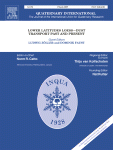Ver ítem
- xmlui.general.dspace_homeCentros e Institutos de InvestigaciónCIRN. Centro de Investigaciones de Recursos NaturalesInstituto de SuelosArtículos científicosxmlui.ArtifactBrowser.ItemViewer.trail
- Inicio
- Centros e Institutos de Investigación
- CIRN. Centro de Investigaciones de Recursos Naturales
- Instituto de Suelos
- Artículos científicos
- Ver ítem
Genesis of subtropical soils with stony horizons in NE Argentina: Autochthony and polygenesis
Resumen
Deep red soils, combining characteristics of highly weathered materials together with a significant degree of clay illuviation and with stony horizons close to the saprolite, are found in the Province of Misiones, northeastern Argentina. Two basic types of stony horizons have been found, which with the fine-grained material above are together considered autochthonous. The first one is a “ferruginous nodular horizon”, composed mainly of in situ goethitic
[ver mas...]
Deep red soils, combining characteristics of highly weathered materials together with a significant degree of clay illuviation and with stony horizons close to the saprolite, are found in the Province of Misiones, northeastern Argentina. Two basic types of stony horizons have been found, which with the fine-grained material above are together considered autochthonous. The first one is a “ferruginous nodular horizon”, composed mainly of in situ goethitic nodules of gravel size resulting from weathering and glaebulization processes of basalt. The second are “siliceous horizons” which are also in situ, derived from pre-existing quartz veins within the basalt. In contrast, different analytical evidences, particularly the vertical and geographical variations in the SOM-stable carbon isotope ratios and the mineralogical composition of fine and coarse fractions, suggest that these red subtropical soils are polygenetic, being the result of a two-fold process linked to paleoecological fluctuations. In the framework of these results, different interpretations about the origin of these soils and their parent materials, and particularly the “tropical loess” theory, are discussed.
[Cerrar]

Autor
Fuente
Quaternary International 196 (1–2) : 137-159 (March 2009)
Fecha
2009-03
Editorial
Elsevier
ISSN
1040-6182
Formato
pdf
Tipo de documento
artículo
Palabras Claves
Derechos de acceso
Restringido
 Excepto donde se diga explicitamente, este item se publica bajo la siguiente descripción: Creative Commons Attribution-NonCommercial-ShareAlike 2.5 Unported (CC BY-NC-SA 2.5)
Excepto donde se diga explicitamente, este item se publica bajo la siguiente descripción: Creative Commons Attribution-NonCommercial-ShareAlike 2.5 Unported (CC BY-NC-SA 2.5)
Metadatos
Mostrar el registro completo del ítemÍtems relacionados
Mostrando ítems relacionados por Título, autor o materia.
-
Rangeland grazing management in Argentine Patagonia
Bjerring, Anna Trier; Peri, Pablo Luis; Christiansen, Rodolfo; Vargas-Bello-Pérez, Einar; Hansen, Hanne Helene (IJAB. Friends science publishers, 2020-08-31)Stocking rate adjustment in grazing management is recommended as a management tool to sustain productivity and improve soil health of permanent grassland ecosystems. The aim of this project was to assess the effect of ... -
Capítulo 6: Manejo del suelo y Fertilización
Apcarian, Alicia; Aruani, María Cristina; Curetti, Mariela; Holzmann, Rosa De Lima; Irrisarri, Jorge A.; Sanchez, Enrique Eduardo; Schmid, Patricia (ProRioNegro, 2010)6.1. Suelos: Las plantas de pera tienen una marcada plasticidad para crecer en diferentes ambientes, incluidos diversos tipos de suelos. Sin embargo, las plantaciones comerciales de este cultivo requieren de una adecuada ... -
Efecto de distintas secuencias de tratamientos de biofumigación durante 20 años, sobre parámetros estructurales del suelo en invernadero
Barbieri, Martin Osvaldo; Muñoz, Soledad; Perello Facciano, Eliana; Celie, Julio César; Brambilla, Maria Virginia; Diaz, Juan Carlos; Richmond, Pablo Federico; Piris, Estela Beatriz; Mitidieri, Mariel Silvina (2024-10-22)

